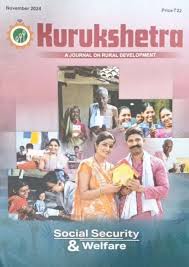November 2024 Kurukshetra
Social Security: Vital for Development and Prosperity
- Social security reduces poverty, promotes social inclusion, and boosts economic growth.
- It enhances incomes, stimulating consumption, savings, investment, and domestic demand, supporting human development.
India’s Social Security Framework
- India’s system includes social insurance, social assistance, Right to Education, and Right to Food schemes, led by the central and state governments.
- It covers family benefits, maternity, unemployment support, health protection, old-age pensions, and disability benefits.
Global Perspective and Sustainable Development
- Social protection is a human right essential for achieving the Sustainable Development Goals (SDGs).
- SDG Goal 1 aims to end poverty by 2030 through national social protection systems.
- Article 22 of the Universal Declaration of Human Rights and ILO’s Social Protection Floors Recommendation affirm social security as a fundamental right.
Need for Universal Social Protection
- 71% of the global population lacks adequate social protection, with children and women particularly underserved.
- ILO’s World Social Protection Report (2024-26) shows 52.4% global coverage by at least one social benefit.
- Comprehensive social protection fosters stability, reduces inequalities, enhances social cohesion, and protects against economic shocks.
Social Security in India
- Evolved to include education, food security, health insurance, employment rights, and support for senior citizens and unorganized workers.
- Aims to provide a safety net for vulnerable populations, enhancing socioeconomic well-being.
Key Areas in India
- Free Primary Education
- Article 21A of the Constitution ensures free education as a fundamental right.
- The Right to Education (RTE) Act of 2009 mandates free education for children aged 6-14.
- Food Security
- The National Food Security Act (NFSA) of 2013 provides subsidized food grains to 75% of the rural and 50% of the urban population.
- Initiatives like PM Garib Kalyan Anna Yojana ensure nutrition, especially during crises like COVID-19.
- Health Insurance for the Poor
- Ayushman Bharat (AB PM-JAY) is the world’s largest health insurance scheme, covering up to ₹5 lakh per family for secondary and tertiary care.
- Right to Work
- MGNREGA guarantees 100 days of wage employment to rural households, enhancing livelihoods and economic security.
- Social Security for Senior Citizens
- Schemes like Indira Gandhi National Old Age Pension and Atal Vayo Abhyuday Yojana provide financial security and healthcare for the elderly.
- Social Protection for Unorganized Sector Workers
- The Code on Social Security, 2020, covers unorganized, gig, and platform workers.
- Insurance schemes like PMJJBY, PMSBY, and PM-SYM provide life, disability, and pension benefits.
Road Ahead
- Effective social security systems require continuous adaptation to demographic changes and social needs.
- 39 countries, mainly in Europe, have achieved near-universal social protection, with models like Uruguay investing over 25% of GDP in social programs.
- Addressing funding gaps is crucial for sustainable social protection systems.
Conclusion
Social security is vital for poverty reduction, social inclusion, and economic growth. In India, comprehensive schemes support vulnerable populations across education, food, health, employment, and old-age security. Globally, universal social protection remains a challenge but is essential for achieving the SDGs and promoting social cohesion and stability. Strengthening social security systems is crucial for inclusive and sustainable development
Social Security and Welfare of Farmers for Building Viksit Bharat
Importance for Viksit Bharat
- Ensuring social security and welfare for farmers is crucial for achieving a prosperous and developed India (Viksit Bharat).
- It enhances agricultural productivity, rural incomes, and food security, contributing to economic growth and social stability.
Social Security Schemes for Farmers
- PM-Kisan Samman Nidhi (PM-KISAN)
- Provides direct income support of ₹6,000 per year to small and marginal farmers.
- Aims to ensure financial stability and reduce dependency on informal credit.
- Crop Insurance – PM Fasal Bima Yojana (PMFBY)
- Protects farmers against crop losses due to natural calamities, pests, and diseases.
- Encourages farmers to adopt innovative and sustainable farming practices.
- Pension Schemes – PM Kisan Maandhan Yojana
- Offers a monthly pension of ₹3,000 for small and marginal farmers aged 60 and above.
- Ensures financial security in old age, reducing rural poverty.
- Subsidies and Support Programs
- Fertilizer subsidies, Minimum Support Price (MSP), and interest subsidies on crop loans.
- These measures enhance affordability, ensuring better returns for agricultural produce.
Welfare Initiatives
- Soil Health and Irrigation
- Soil Health Card Scheme and Pradhan Mantri Krishi Sinchayee Yojana (PMKSY) improve soil fertility and irrigation facilities.
- Promotes efficient resource use and sustainable agriculture.
- Market Access and Digital Initiatives
- e-NAM (National Agriculture Market) facilitates online trading, ensuring better prices and wider market access.
- Digital platforms empower farmers with real-time information on weather, prices, and best practices.
- Skill Development and Education
- Krishi Vigyan Kendras (KVKs) and various training programs educate farmers on modern techniques.
- Enhances productivity and reduces dependence on traditional methods.
Road Ahead
- To build a Viksit Bharat, it’s essential to strengthen social security and welfare programs for farmers.
- This includes expanding digital infrastructure, ensuring fair prices, enhancing insurance coverage, and promoting sustainable agriculture practices.
Conclusion
Social security and welfare programs for farmers are pivotal for transforming India into a prosperous and developed nation. By ensuring financial stability, access to resources, and market opportunities, these initiatives uplift the agricultural sector, driving economic growth and social equity. A resilient and empowered farming community is the backbone of a Viksit Bharat.


